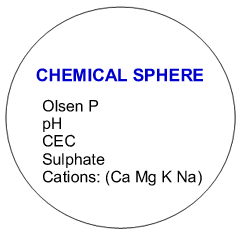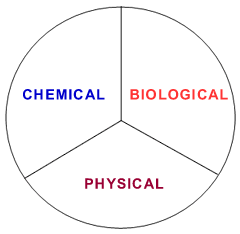 |
 |
| Home | About Us | Our Services | Info Centre | Article Archive | Field Reps/Agents | Contact Us |
Information CentreSoil SpheresMany soil tests undertaken in NZ examine soil properties that belong to what could be termed the chemical sphere. Part of the reason for this, is that they are easier (and therefore cheaper) to assess than other soil properties.
Each sphere interacts with the other two spheres i.e. chemical sphere properties impact and are impacted by biological and physical sphere properties etc. Thus, when we try and understand soil function but only examime a handful of chemical sphere parameters, it is easy to be led to the wrong conclusion about that soil. Essential Macro and Trace ElementsIn addition to the main macro-nutrients (Nitrogen, Phosphorus, Potassium, Sulphur, Calcium, Magnesium, Sodium), there are at least 7 trace elements required by plants for proper growth and function (iron, manganese, zinc, copper, boron, molybdenum and chlorine). There are a further 5 that are essential for animals (cobalt, selenium, chromium, iodine, and fluorine). Of these the most likely to be limiting are zinc, copper, boron, molybdenum, cobalt, selenium and iodine.
Soiltech Test ResultsSoiltech provides a range of report options, interpreting the results of tests undertaken clearly and meaningfully. The data from each test is presented in clear, easy to follow tabular and graphical formats. This enables quick comprehension of the nutrient status of the sample. The relative abundance of nutrients is indicated. This enables the assessment of possible negative interactions between elements.
View results in tabular format » There are three different reporting options available; comprehensive, abridged or summary (existing clients only) reports. The result of each parameter tested and its significance is discussed briefly in the comprehensive and abridged reports. A comparison is made between the current status of the sample tested and the ideal "desired level" relative to the particular enterprise under consideration etc. The comprehensive report discusses the results in more detail than the abridged report, focussing on issues such as any interactions or nutrient antagonisms which may impact on the parameters tested.
|
|
© 2007 Soiltech Ltd. All rights reserved.
|

